This article was medically reviewed by Kevin Stone, MD. Dr. Kevin Stone is an orthopaedic surgeon and the founder of The Stone Clinic, a leading orthopaedic surgery, sports medicine, and rehabilitation clinic in the San Francisco Bay Area. With over 30 years of experience, Dr. Stone specializes in knee, shoulder, and ankle repair, using biologic reconstruction and joint replacement. He holds a BS in Biology from Harvard University and a Doctor of Medicine (MD) from the University of North Carolina at Chapel Hill. Dr. Stone completed his residency in Internal Medicine and Orthopaedic Surgery at Harvard University and in General Surgery at Stanford University. He then completed a fellowship in Orthopaedic Research and Surgery at the Hospital for Special Surgery and Tahoe Orthopaedics. He lectures around the world as an expert in cartilage and meniscal growth, replacement, and repair and holds over 40 U.S. patents on novel inventions to improve healthcare. Dr. Stone is a physician for Smuin Ballet and has served as a physician for the U.S. Ski Team, the U.S. Pro Ski Tour, the United States Olympic Training Center, and World Pro Ski Tour.
There are 9 references cited in this article, which can be found at the bottom of the page.
This article has been viewed 133,623 times.
Experts say that if you have been experiencing pain, swelling, or tenderness in your legs or feet, you could be suffering from an undiagnosed stress fracture.[1] Running, walking, and jumping may be especially painful, an upsetting experience if you are an athlete, or even just a weekly walker. Anyone can develop stress fractures, from sedentary people to Olympic athletes. Studies show that by being aware of the risk factors, understanding the symptoms, and getting a professional diagnosis, you can identify and confirm the source of your injury.[2]
Steps
Recognizing Common Symptoms
-
1Take notice of an intense or worsening pain. Pain in the affected area is the most common symptom of stress fracture, especially pain that intensifies with activity.[3] Although pain from a stress fracture can be barely noticeable at first, it may become worse over time.[4]
- The pain may be sharp, pulsating and excruciating.
-
2Keep an eye out for inflammation, swelling, or bruising. If inflammation, swelling, or bruising is present at the site of pain, this indicates the possibility of a stress fracture. Some areas where you might notice inflammation, swelling, or bruising include:[5]
- On the top of your foot.
- Along your shin (the front of your calf).
- Around your ankle or heel.
Advertisement -
3Notice the presence of localized tenderness. Localized tenderness usually originates from a specific spot and decreases during rest. Tenderness or a feeling of a palpitating soft object can be due to inflammation in the affected area. Touch the affected area to see if it is tender.[6]
-
4Note any muscle spasms. When the muscle fibers in the injured area stretch or tear due to stress fracture, they contract. This contraction may lead to muscle spasms and more pain in the affected area.[7] You may notice that the area feels tight, cramped, or achy.
Evaluating Your Risk Factors
-
1Monitor any weight bearing exercise or exercises with repetitive motions. Stress fractures are caused by putting too much weight or pressure on the weight bearing bones of the body, such as the legs and feet. This weight can cause an imbalance in the growth of new bone cells, and constant overuse of weight bearing bones can lead to bone exhaustion, cracking the bone and leading to the development of a stress fracture.[8]
- Low-impact exercises, like yoga, can cause stress fractures too if they use too much repetitive motion. These fractures are more likely to appear in the feet.[9]
- Stress fractures usually occur in the tibia (shin bone), fibula (lower leg bones), metatarsals (bones of the feet), navicular (bones of the mid foot). They occur less often in the hip bones, pelvis, and sacrum.[10]
-
2Consider a recent increase in activity. People who increase their physical activity after being sedentary for a long time have a higher likelihood of developing stress fractures.[11] This can come as a shock, and be the first sign of overtraining.
- If you have just upped your running mileage dramatically, or recently started a new regimen, then you may be suffering from a stress fracture.
-
3Know that athletes are at a heightened risk of stress fractures. Many sports, such as track and field, basketball, tennis, and gymnastics cause repetitive stress on the bones.[12] This stress is due to the foot striking the ground, causing trauma that can lead to stress fractures.[13]
- Athletes who overtrain on different surfaces and those who use substandard equipment, like worn out athletic shoes, are at an increased risk for stress fractures.
-
4Identify preexisting medical conditions that heighten your risk. People with preexisting medical conditions, especially osteoporosis, are prone to developing stress fractures because they have weak and brittle bones.[14]
- Osteoporosis weakens the bone and a stress fracture can develop.
-
5Track your use of corticosteroids. Corticosteroids provide relief for conditions like arthritis, skin rashes, and asthma. Corticosteroids can, however, increase your risk of getting a fracture, especially if you have been using them for a long time. When getting your injury examined, be sure to tell your doctor if you are using corticosteroids.[15]
-
6Be aware that women are more prone to stress fractures. Women, especially those who exercise and diet to an extreme degree, have irregular periods, and have osteoporosis, are at an increased risk of stress fractures. This is known as the female athlete triad and it leads to brittle bones that are likely to break easily.[16]
-
7Reflect on any history of foot problems. Individuals with foot problems, like flat feet or high and rigid arches, are prone to developing stress fractures. This is due to the imbalance these foot abnormalities cause during weight bearing activities. If you have a history of foot problems, then it is more likely that you will experience a stress fracture.[17]
-
8Consider lifestyle factors that can affect your risk of stress fracture. People who drink more than 10 alcoholic drinks a week or smoke are at a higher risk of developing stress fractures.[18] This is because substances in alcohol and cigarettes tend to reduce bone density.
- Additionally, people with eating disorders have reduced amounts of calcium and vitamin D, nutrients that are necessary for strengthening the bones.[19]
Getting a Professional Diagnosis
-
1See your doctor. Check with your doctor or a specialist (podiatrist or an orthopedic surgeon) if you experience pain while doing weight-bearing exercises such as walking, running, and jogging. Remember that in the case of a stress fracture, the pain usually subsides at rest, but when the pain, discomfort and swelling do not subside, it is best to head to the emergency department of the nearest hospital or treatment facility.[20]
- If left untreated for too long, a stress fracture can cause quite a bit of damage.
-
2Discuss your medical history. The doctor will interview you and ask you some questions to gather information. This information will aid the doctor in accurately diagnosing a stress fracture.[21] The doctor can also evaluate your risk factors for developing a stress fracture with this information.
-
3Get a physical examination. During a physical examination, a doctor will inspect, palpate and percuss the affected area. This may be enough for the doctor to make a diagnosis, because symptoms such as tenderness, pain, and swelling can be detected in this manner.[22]
-
4Get an x-ray. An x-ray may not show evidence of stress fractures, but it can be used to detect signs of a stress fracture several weeks after the symptoms begin. This can show when the bone starts to remodel and heal at the fracture site. In this case, an x-ray may help the doctor confirm the diagnosis.[23]
- Since stress fractures might only appear to be a crack in the bone, their extent and severity may not be visible in a routine x-ray.
- If the x-ray is unsuccessful, further imaging may be necessary.
-
5Ask about a computed tomography scan. Computed tomography (CT) scans take computerized images and convert them to provide a clearer picture of the affected site and its surrounding joints, ligaments and bones. This may help to detect a stress fracture if an x-ray does not identify the problem.[24]
-
6Go for a bone scan. A bone scan uses a radioactive tracer injected through an intravenous line to demonstrate areas where bone cells have increased activity and blood supply. These areas indicate that there has been bone repair with a bright white spot on the scan image. However, a stress fracture may look the same as another type of bone injury on a bone scan, so it is not the most accurate imaging test for identifying stress fractures.[25]
-
7Ask about magnetic resonance imaging (MRI). An MRI uses radio and magnetic field waves to form a more detailed and clear picture of the scanned body structure. You can have an MRI within the first week of the injury to identify a stress fracture. This will provide the most accurate results and can distinguish between a stress fracture and soft tissue injury.[26]
-
8Talk to your doctor about treatment options. In most cases, all you need to do is to rest and stop any vigorous activities until your injuries heal.[27] If your injury hasn't healed in 6-8 weeks, your doctor may recommend surgery to insert screws into the foot. You may need to wear special footwear for a few weeks after this surgery.[28]
- It is a good idea to stop the activity that caused your stress fracture for 6-8 weeks after your injury.
- Ask your doctor if calcium or vitamin D supplements can help you as you heal.
Expert Q&A
Did you know you can get premium answers for this article?
Unlock premium answers by supporting wikiHow
-
QuestionHow do you know if a rib is fractured?
 Kevin Stone, MDDr. Kevin Stone is an orthopaedic surgeon and the founder of The Stone Clinic, a leading orthopaedic surgery, sports medicine, and rehabilitation clinic in the San Francisco Bay Area. With over 30 years of experience, Dr. Stone specializes in knee, shoulder, and ankle repair, using biologic reconstruction and joint replacement. He holds a BS in Biology from Harvard University and a Doctor of Medicine (MD) from the University of North Carolina at Chapel Hill. Dr. Stone completed his residency in Internal Medicine and Orthopaedic Surgery at Harvard University and in General Surgery at Stanford University. He then completed a fellowship in Orthopaedic Research and Surgery at the Hospital for Special Surgery and Tahoe Orthopaedics. He lectures around the world as an expert in cartilage and meniscal growth, replacement, and repair and holds over 40 U.S. patents on novel inventions to improve healthcare. Dr. Stone is a physician for Smuin Ballet and has served as a physician for the U.S. Ski Team, the U.S. Pro Ski Tour, the United States Olympic Training Center, and World Pro Ski Tour.
Kevin Stone, MDDr. Kevin Stone is an orthopaedic surgeon and the founder of The Stone Clinic, a leading orthopaedic surgery, sports medicine, and rehabilitation clinic in the San Francisco Bay Area. With over 30 years of experience, Dr. Stone specializes in knee, shoulder, and ankle repair, using biologic reconstruction and joint replacement. He holds a BS in Biology from Harvard University and a Doctor of Medicine (MD) from the University of North Carolina at Chapel Hill. Dr. Stone completed his residency in Internal Medicine and Orthopaedic Surgery at Harvard University and in General Surgery at Stanford University. He then completed a fellowship in Orthopaedic Research and Surgery at the Hospital for Special Surgery and Tahoe Orthopaedics. He lectures around the world as an expert in cartilage and meniscal growth, replacement, and repair and holds over 40 U.S. patents on novel inventions to improve healthcare. Dr. Stone is a physician for Smuin Ballet and has served as a physician for the U.S. Ski Team, the U.S. Pro Ski Tour, the United States Olympic Training Center, and World Pro Ski Tour.
Board Certified Orthopaedic Surgeon
-
QuestionAre fractured ribs dangerous?
 Kevin Stone, MDDr. Kevin Stone is an orthopaedic surgeon and the founder of The Stone Clinic, a leading orthopaedic surgery, sports medicine, and rehabilitation clinic in the San Francisco Bay Area. With over 30 years of experience, Dr. Stone specializes in knee, shoulder, and ankle repair, using biologic reconstruction and joint replacement. He holds a BS in Biology from Harvard University and a Doctor of Medicine (MD) from the University of North Carolina at Chapel Hill. Dr. Stone completed his residency in Internal Medicine and Orthopaedic Surgery at Harvard University and in General Surgery at Stanford University. He then completed a fellowship in Orthopaedic Research and Surgery at the Hospital for Special Surgery and Tahoe Orthopaedics. He lectures around the world as an expert in cartilage and meniscal growth, replacement, and repair and holds over 40 U.S. patents on novel inventions to improve healthcare. Dr. Stone is a physician for Smuin Ballet and has served as a physician for the U.S. Ski Team, the U.S. Pro Ski Tour, the United States Olympic Training Center, and World Pro Ski Tour.
Kevin Stone, MDDr. Kevin Stone is an orthopaedic surgeon and the founder of The Stone Clinic, a leading orthopaedic surgery, sports medicine, and rehabilitation clinic in the San Francisco Bay Area. With over 30 years of experience, Dr. Stone specializes in knee, shoulder, and ankle repair, using biologic reconstruction and joint replacement. He holds a BS in Biology from Harvard University and a Doctor of Medicine (MD) from the University of North Carolina at Chapel Hill. Dr. Stone completed his residency in Internal Medicine and Orthopaedic Surgery at Harvard University and in General Surgery at Stanford University. He then completed a fellowship in Orthopaedic Research and Surgery at the Hospital for Special Surgery and Tahoe Orthopaedics. He lectures around the world as an expert in cartilage and meniscal growth, replacement, and repair and holds over 40 U.S. patents on novel inventions to improve healthcare. Dr. Stone is a physician for Smuin Ballet and has served as a physician for the U.S. Ski Team, the U.S. Pro Ski Tour, the United States Olympic Training Center, and World Pro Ski Tour.
Board Certified Orthopaedic Surgeon
-
QuestionHow are stress fractures diagnosed?
 Kevin Stone, MDDr. Kevin Stone is an orthopaedic surgeon and the founder of The Stone Clinic, a leading orthopaedic surgery, sports medicine, and rehabilitation clinic in the San Francisco Bay Area. With over 30 years of experience, Dr. Stone specializes in knee, shoulder, and ankle repair, using biologic reconstruction and joint replacement. He holds a BS in Biology from Harvard University and a Doctor of Medicine (MD) from the University of North Carolina at Chapel Hill. Dr. Stone completed his residency in Internal Medicine and Orthopaedic Surgery at Harvard University and in General Surgery at Stanford University. He then completed a fellowship in Orthopaedic Research and Surgery at the Hospital for Special Surgery and Tahoe Orthopaedics. He lectures around the world as an expert in cartilage and meniscal growth, replacement, and repair and holds over 40 U.S. patents on novel inventions to improve healthcare. Dr. Stone is a physician for Smuin Ballet and has served as a physician for the U.S. Ski Team, the U.S. Pro Ski Tour, the United States Olympic Training Center, and World Pro Ski Tour.
Kevin Stone, MDDr. Kevin Stone is an orthopaedic surgeon and the founder of The Stone Clinic, a leading orthopaedic surgery, sports medicine, and rehabilitation clinic in the San Francisco Bay Area. With over 30 years of experience, Dr. Stone specializes in knee, shoulder, and ankle repair, using biologic reconstruction and joint replacement. He holds a BS in Biology from Harvard University and a Doctor of Medicine (MD) from the University of North Carolina at Chapel Hill. Dr. Stone completed his residency in Internal Medicine and Orthopaedic Surgery at Harvard University and in General Surgery at Stanford University. He then completed a fellowship in Orthopaedic Research and Surgery at the Hospital for Special Surgery and Tahoe Orthopaedics. He lectures around the world as an expert in cartilage and meniscal growth, replacement, and repair and holds over 40 U.S. patents on novel inventions to improve healthcare. Dr. Stone is a physician for Smuin Ballet and has served as a physician for the U.S. Ski Team, the U.S. Pro Ski Tour, the United States Olympic Training Center, and World Pro Ski Tour.
Board Certified Orthopaedic Surgeon
References
- ↑ https://www.mayoclinic.org/diseases-conditions/stress-fractures/symptoms-causes/syc-20354057
- ↑ https://www.mayoclinic.org/diseases-conditions/stress-fractures/symptoms-causes/syc-20354057
- ↑ https://www.aafp.org/afp/2011/0101/p39.html
- ↑ https://www.mayoclinic.org/diseases-conditions/stress-fractures/symptoms-causes/syc-20354057
- ↑ https://orthoinfo.aaos.org/en/diseases--conditions/stress-fractures-of-the-foot-and-ankle
- ↑ https://orthoinfo.aaos.org/en/diseases--conditions/stress-fractures-of-the-foot-and-ankle
- ↑ https://www.emedicinehealth.com/bone_fracture_broken_bone/article_em.htm#bone_fracture_causes
- ↑ Kevin Stone, MD. Board Certified Orthopaedic Surgeon. Expert Interview. 19 November 2020.
- ↑ Kevin Stone, MD. Board Certified Orthopaedic Surgeon. Expert Interview. 19 November 2020.
- ↑ https://www.aafp.org/afp/2011/0101/p39.html
- ↑ https://www.aafp.org/afp/2011/0101/p39.html
- ↑ https://www.aafp.org/afp/2011/0101/p39.html
- ↑ Kevin Stone, MD. Board Certified Orthopaedic Surgeon. Expert Interview. 19 November 2020.
- ↑ https://www.mayoclinic.org/diseases-conditions/stress-fractures/symptoms-causes/syc-20354057
- ↑ http://www.medsafe.govt.nz/Profs/PUarticles/bone.htm
- ↑ https://orthoinfo.aaos.org/en/diseases--conditions/stress-fractures-of-the-foot-and-ankle
- ↑ https://www.mayoclinic.org/diseases-conditions/stress-fractures/symptoms-causes/syc-20354057
- ↑ https://www.aafp.org/afp/2011/0101/p39.html
- ↑ https://www.mayoclinic.org/diseases-conditions/stress-fractures/symptoms-causes/syc-20354057
- ↑ Kevin Stone, MD. Board Certified Orthopaedic Surgeon. Expert Interview. 19 November 2020.
- ↑ https://www.mayoclinic.org/diseases-conditions/stress-fractures/diagnosis-treatment/drc-20354063
- ↑ https://www.mayoclinic.org/diseases-conditions/stress-fractures/diagnosis-treatment/drc-20354063
- ↑ https://www.mayoclinic.org/diseases-conditions/stress-fractures/diagnosis-treatment/drc-20354063
- ↑ https://www.mayoclinic.org/diseases-conditions/stress-fractures/diagnosis-treatment/drc-20354063
- ↑ https://www.mayoclinic.org/diseases-conditions/stress-fractures/diagnosis-treatment/drc-20354063
- ↑ https://www.mayoclinic.org/diseases-conditions/stress-fractures/diagnosis-treatment/drc-20354063
- ↑ Kevin Stone, MD. Board Certified Orthopaedic Surgeon. Expert Interview. 19 November 2020.
- ↑ http://www.aofas.org/footcaremd/conditions/ailments-of-the-midfoot/Pages/Stress-Fractures.aspx
About This Article
A stress fracture is a tiny crack in your foot or leg bone, which is usually caused by repeated force, like running long distances or jumping repeatedly. The most common sign of a stress fracture is pain that gets progressively worse, especially with physical activity. Other symptoms include inflammation, swelling, and bruising around the area, small muscle spasms, and tender skin around the injury. In general, your foot or leg might feel tight, cramped, or achy. If the pain in your foot or leg doesn't go away on its own, visit your doctor for a diagnosis and treatment. Usually, your fracture will heal on its own within a few weeks, but they may prescribe some medication to help you. For more information from our Medical co-author, including common risk factors for stress fractures, read on.

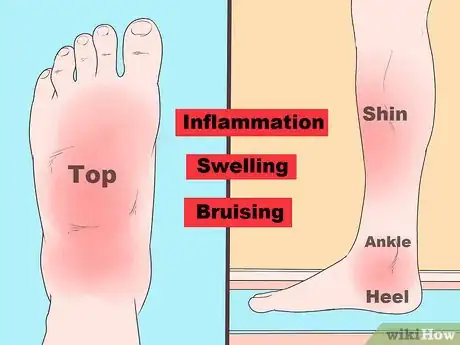
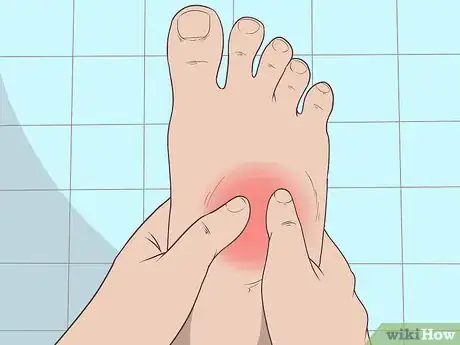
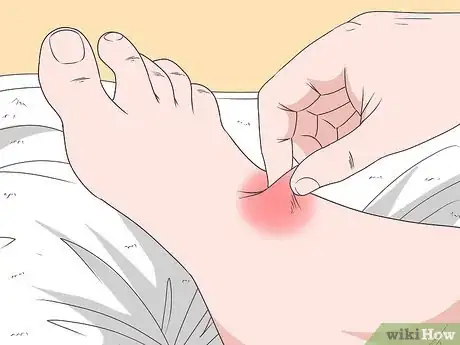



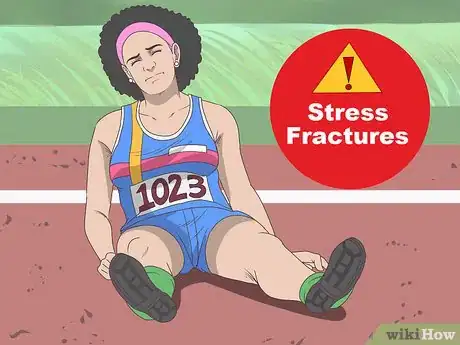
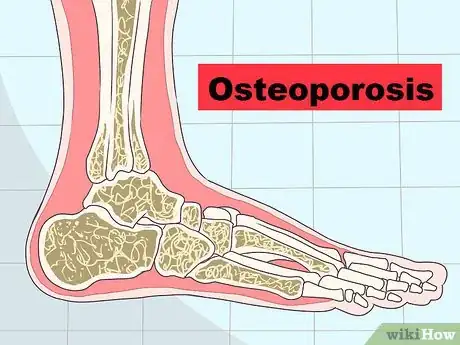


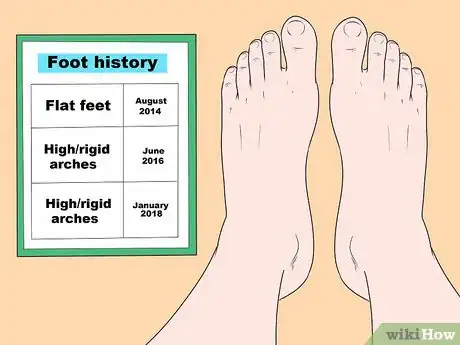



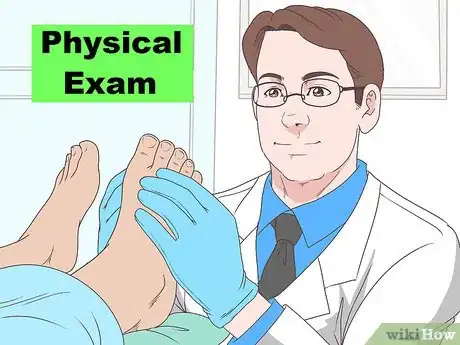
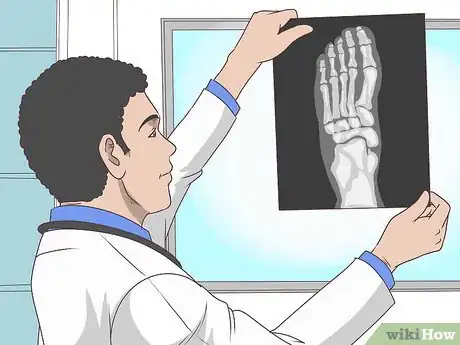


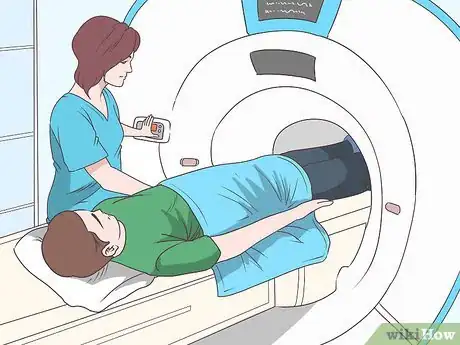









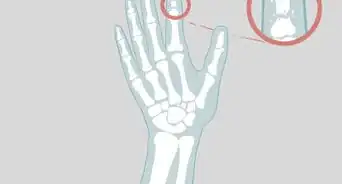


















































Medical Disclaimer
The content of this article is not intended to be a substitute for professional medical advice, examination, diagnosis, or treatment. You should always contact your doctor or other qualified healthcare professional before starting, changing, or stopping any kind of health treatment.
Read More...